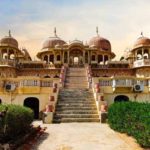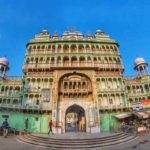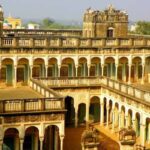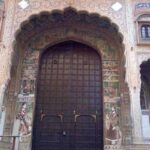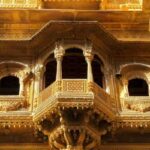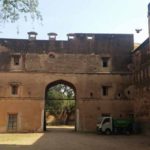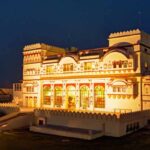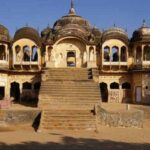Places to Visit in Mukundgarh, a small town located in the Jhunjhunu district of Rajasthan, India, may not be as famous as some of the other tourist destinations in Rajasthan, but it offers a unique and enriching experience for travelers seeking to explore the rich cultural heritage and architectural beauty of the region Rajasthan Monuments.
Mukundgarh is known for its historical charm, and a prominent attraction is the Mukundgarh Fort. Built in the 18th century, this magnificent fort showcases the architectural brilliance of the Rajput era. The fort is adorned with beautiful frescoes, intricate carvings, and ornate jharokhas (balconies). Exploring the fort is like stepping back in time, allowing visitors to appreciate the grandeur of Rajasthan’s royal past.
The town is also famous for its grand havelis (traditional mansions). These havelis, built by wealthy merchants during the 18th and 19th centuries, are architectural marvels. They feature exquisite frescoes, murals, and mirror work, reflecting the opulence and artistic flair of the bygone era. Kanoria Haveli, Ganeriwala Haveli, and Goenka Haveli are some notable havelis that visitors should not miss.
For spiritual seekers, the Harsh Nath Temple is a must-visit. Situated atop a hill near Mukundgarh, this ancient temple dedicated to Lord Shiva offers breathtaking panoramic views of the surrounding countryside. The temple’s serene ambiance and spiritual aura make it a peaceful place for meditation and introspection.
Mukundgarh is also famous for its intricate frescoes adorning the walls of houses and buildings. Taking a stroll through the town, visitors can explore the fresco trails and marvel at the beautiful artwork depicting scenes from mythology, historical events, and everyday life. The frescoes are a testimony to the artistic brilliance and cultural heritage of the region.
The local bazaars in Mukundgarh are vibrant and offer a wide range of traditional Rajasthani handicrafts, textiles, jewelry, and pottery. Visitors can indulge in shopping for souvenirs and immerse themselves in the colors, textures, and craftsmanship of Rajasthan’s artistic traditions Rajasthan Budget Tours.
While in Mukundgarh, visitors can also consider exploring nearby attractions such as Roop Niwas Palace, a heritage hotel known for its elegant architecture and lush gardens, and Dundlod Fort, another magnificent fort that provides insights into the region’s history.
In conclusion, Mukundgarh may be a small town, but it offers a treasure trove of cultural and architectural gems. From the majestic Mukundgarh Fort and grand havelis to spiritual temples, vibrant frescoes, and bustling bazaars, the town has much to offer to travelers seeking an authentic Rajasthani experience. A visit to Mukundgarh promises a journey through history, art, and spirituality, leaving visitors with lasting memories of Rajasthan’s rich heritage.
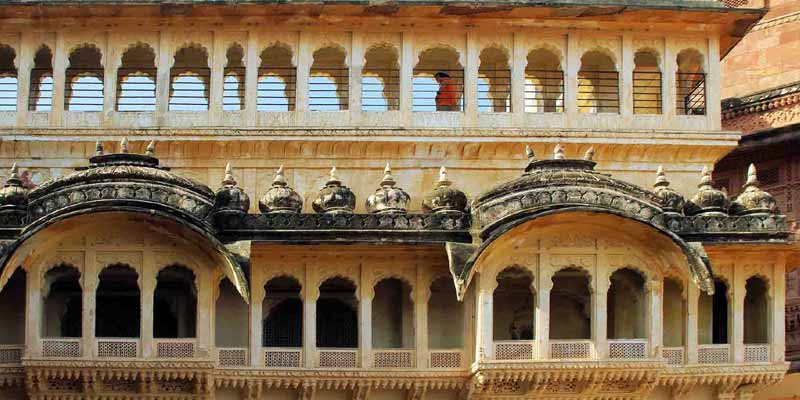
Mukundgarh Fort
Mukundgarh Fort, located in the town of Mukundgarh in the Jhunjhunu district of Rajasthan, India, is a splendid architectural marvel that offers a glimpse into the rich history and cultural heritage of the region. Built in the 18th century, the fort stands tall as a testimony to the grandeur and opulence of the Rajput era.
The Mukundgarh Fort is renowned for its exquisite architecture, intricate carvings, and beautiful frescoes. As you approach the fort, you are greeted by massive gateways and towering walls that enclose the complex. The fort’s massive structure showcases the defensive capabilities of its time, designed to protect the royal family and its inhabitants.
Upon entering the fort, you are welcomed into a world of architectural brilliance. The interiors of the fort are adorned with stunning frescoes, which depict scenes from mythology, historical events, and everyday life. These vibrant and detailed frescoes are a testament to the artistic prowess of the Rajasthani craftsmen who created them. The intricate carvings and ornate jharokhas (balconies) add to the fort’s grandeur, providing a visual treat for visitors.
Exploring the Mukundgarh Fort allows you to traverse through its various sections, including courtyards, palaces, temples, and gardens. The fort’s courtyards were once the center of royal activities, hosting grand celebrations and events. The palaces within the fort showcase the luxurious lifestyle of the Rajput rulers, with their elegant architecture and lavish interiors. The temples within the fort complex offer a glimpse into the spiritual beliefs and practices of the era.
Apart from its architectural splendor, Mukundgarh Fort holds historical significance. It served as a stronghold for the noble Shekhawat Rajputs and played a crucial role in protecting the region from invasions. The fort stands as a silent witness to the rich history and valor of the rulers of Mukundgarh.
Today, Mukundgarh Fort is a popular tourist attraction that attracts visitors from across the globe. It offers a unique opportunity to delve into Rajasthan’s regal past and immerse oneself in the architectural brilliance and cultural heritage of the region. A visit to Mukundgarh Fort is a journey back in time, allowing visitors to appreciate the craftsmanship, artistry, and grandeur of Rajasthan’s royal legacy.
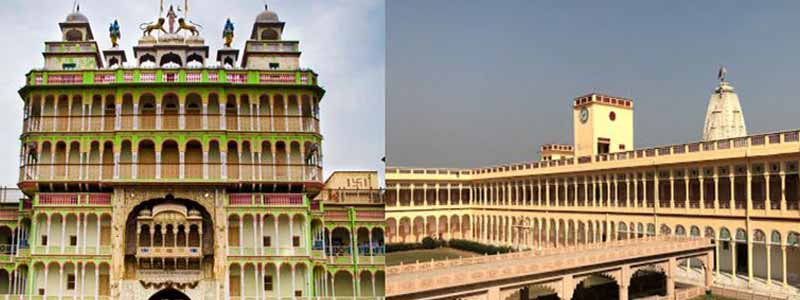
Rani Sati Temple
Rani Sati Temple, located in the town of Mukundgarh in the Jhunjhunu district of Rajasthan, India, is a revered Hindu temple dedicated to Rani Sati, a legendary figure known for her courage and devotion. The temple holds immense religious and cultural significance and attracts devotees from far and wide.
The Rani Sati Temple is believed to have been built around 400 years ago and stands as a testament to the timeless devotion of Rani Sati. The temple’s architecture follows traditional Rajasthani style, with intricate carvings, exquisite domes, and beautiful paintings adorning its structure.
The main sanctum of the temple houses the idol of Rani Sati, who is venerated as a manifestation of the divine feminine energy. Devotees offer prayers, light incense, and make offerings to seek the blessings of Rani Sati. The temple complex also includes other smaller shrines dedicated to various deities, creating a serene and sacred atmosphere.
One of the unique aspects of the Rani Sati Temple is the sacred flame that has been continuously burning for centuries. This flame, known as the “Akhand Jyoti,” is considered divine and symbolizes the eternal presence of Rani Sati’s divine energy. Devotees offer oil lamps and pray in front of the flame, seeking strength, protection, and fulfillment of their wishes.
The temple holds a significant place in the hearts of devotees who have deep faith in Rani Sati’s divine blessings. It is believed that offering prayers and seeking the blessings of Rani Sati can bring prosperity, happiness, and fulfillment of desires. Devotees visit the temple on various occasions, including special festivals and auspicious days associated with Rani Sati.
Apart from its religious significance, the Rani Sati Temple is also known for its architectural beauty and intricate craftsmanship. The walls of the temple are adorned with colorful frescoes, depicting mythological scenes and the life of Rani Sati. These paintings add to the spiritual ambiance of the temple and captivate the attention of visitors.
Visiting the Rani Sati Temple in Mukundgarh offers not only a spiritual experience but also an opportunity to witness the rich cultural heritage and religious traditions of Rajasthan. The temple’s serene surroundings, ancient rituals, and deep-rooted beliefs provide a profound connection to the devotion and faith of the devotees.
The Rani Sati Temple stands as a symbol of faith, devotion, and reverence in Mukundgarh, attracting devotees and tourists alike. It is a place where individuals can find solace, seek blessings, and immerse themselves in the divine energy of Rani Sati.
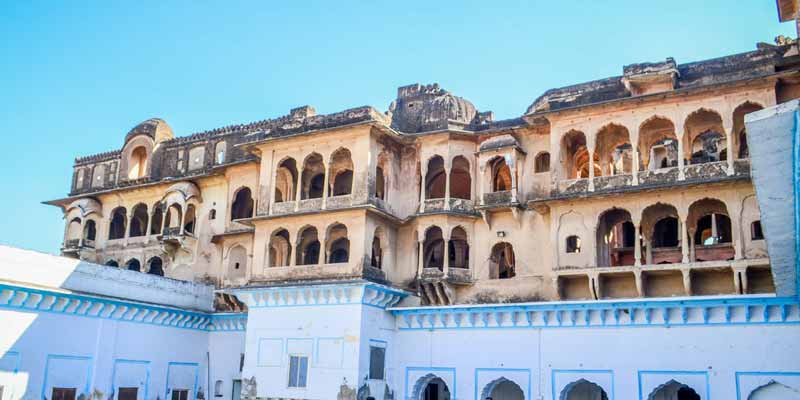
Khetri Mahal
Khetri Mahal, also known as Wind Palace or Abhaneri Mahal, is a historic palace located in the town of Mukundgarh in the Jhunjhunu district of Rajasthan, India. It is a remarkable architectural gem that showcases the grandeur and artistic finesse of the bygone era.
Khetri Mahal was constructed in the 18th century and served as a residence for the royal family of Khetri. The palace stands as a testament to the rich cultural heritage and architectural brilliance of Rajasthan. It is renowned for its unique blend of Rajput and Mughal architectural styles, making it a visual delight for visitors.
The palace derives its name, Wind Palace, due to its strategic design that facilitates the circulation of cool air throughout the premises. The palace features a series of intricately carved jharokhas (balconies) and windows, which allow the passage of air and create a natural ventilation system. This thoughtful architectural feature is especially significant in the scorching heat of Rajasthan, providing a comfortable living environment.
Khetri Mahal boasts a majestic structure with stunning geometric patterns, elaborate carvings, and exquisite frescoes. The intricate artwork adorning the walls and ceilings showcases the skilled craftsmanship and attention to detail of the artisans of that era. The frescoes depict scenes from mythology, Rajput history, and daily life, showcasing the vibrant colors and rich cultural heritage of Rajasthan.
The palace complex comprises multiple courtyards, spacious rooms, and interconnected corridors. Each section of the palace reflects the luxurious lifestyle of the royal family. The interior walls are adorned with beautiful mirror work, further enhancing the palace’s charm and elegance.
Visiting Khetri Mahal provides a glimpse into the regal lifestyle and architectural splendor of the past. Exploring the palace allows visitors to immerse themselves in the grandeur and opulence of Rajasthan’s royal heritage. The intricate carvings, detailed frescoes, and magnificent architecture create a captivating ambiance that transports visitors back in time.
Today, Khetri Mahal serves as a heritage site and a popular tourist attraction in Mukundgarh. Visitors can marvel at the architectural intricacies, appreciate the artistic mastery, and gain insights into the cultural and historical significance of the palace. It is a must-visit destination for history enthusiasts, architecture lovers, and anyone seeking to delve into the glorious past of Rajasthan.
Khetri Mahal stands as a proud symbol of Rajasthan’s rich history and architectural legacy. Its timeless beauty and cultural significance make it a cherished landmark in Mukundgarh, attracting tourists and historians who wish to witness the grandeur and magnificence of this architectural marvel.
Bihari Ji Temple
Bihari Ji Temple, located in the town of Mukundgarh in the Jhunjhunu district of Rajasthan, India, is a revered Hindu temple dedicated to Lord Krishna in his form as Bihari Ji. The temple holds immense religious significance and serves as a hub of devotion and spirituality for devotees.
Bihari Ji Temple is believed to have been built several centuries ago and has since become a prominent pilgrimage site for Krishna devotees. The temple’s architecture follows traditional Rajasthani style, with intricate carvings, beautiful domes, and vibrant colors adorning its structure.
The main sanctum of the temple houses the idol of Bihari Ji, a manifestation of Lord Krishna. The idol, made of black stone, depicts Krishna in a standing posture, adorned with exquisite jewelry and garments. Devotees offer prayers, sing devotional hymns, and participate in religious ceremonies to seek the blessings of Bihari Ji.
The temple complex also houses smaller shrines dedicated to other deities such as Radha, Rukmini, and other manifestations of Lord Krishna. These shrines create a serene and spiritual atmosphere, where devotees can offer their prayers and perform rituals.
One of the unique aspects of Bihari Ji Temple is the arti (ritual of offering prayers with lamps) that takes place every day. Devotees gather to witness this sacred ritual, which involves the chanting of hymns, ringing of bells, and waving of oil lamps in front of the deity. The arti creates a captivating and divine ambiance, filling the temple premises with spiritual energy.
The temple also celebrates various festivals dedicated to Lord Krishna with great enthusiasm and devotion. Janmashtami, the birth anniversary of Lord Krishna, is one of the most significant celebrations at Bihari Ji Temple. The temple premises are adorned with colorful decorations, and devotees engage in singing devotional songs, reenacting episodes from Krishna’s life, and participating in processions.
Visiting Bihari Ji Temple provides a profound spiritual experience for devotees and tourists alike. The serene surroundings, melodious bhajans (devotional songs), and the fragrance of incense create an atmosphere of divine bliss. The temple serves as a sanctuary where individuals can connect with their faith and seek solace and guidance from Lord Krishna.
Bihari Ji Temple holds a special place in the hearts of devotees who flock to the temple to offer their prayers and seek blessings. It stands as a symbol of devotion and faith in Mukundgarh, attracting devotees from all walks of life. A visit to this sacred temple is an opportunity to witness the religious fervor and cultural heritage of Rajasthan, while also experiencing the spirituality and tranquility that envelops the temple premises.
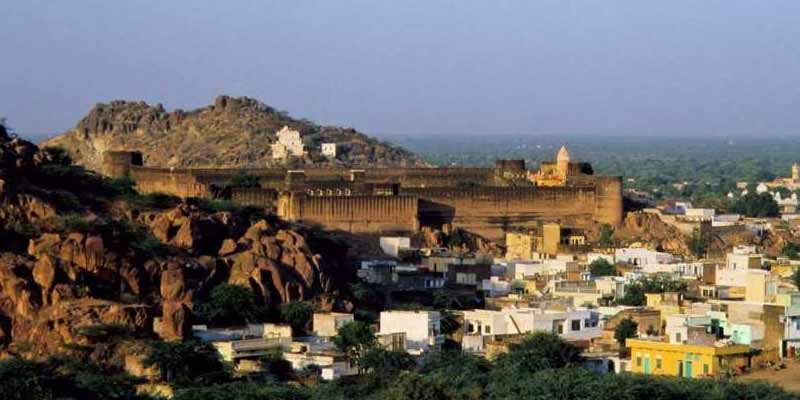
Badalgarh Fort
Badalgarh Fort, located in the town of Mukundgarh in the Jhunjhunu district of Rajasthan, India, is a historical fort that stands as a testament to the valor and architectural brilliance of the Rajput rulers. The fort, perched on a hill, offers breathtaking views of the surrounding landscape and serves as a prominent attraction in the region.
Badalgarh Fort was built in the 18th century and served as a strategic stronghold for the Kachhwaha Rajputs. The fort’s name, which translates to “Fort of Clouds,” is derived from the mist and clouds that often envelop the hilltop, creating a mystical atmosphere.
The fort is known for its impressive architecture and sturdy structure. It features massive walls, imposing gateways, and watchtowers that provide a glimpse into its defensive capabilities. The fort’s strategic location atop a hill offered a vantage point for monitoring the surrounding areas and safeguarding the region from invasions.
Exploring Badalgarh Fort allows visitors to delve into its rich history and witness the architectural grandeur of the past. The fort complex consists of several palaces, courtyards, temples, and gardens. The palaces, with their ornate interiors, showcase the regal lifestyle of the Rajput rulers. The intricate carvings, delicate frescoes, and detailed artwork adorning the walls and ceilings are a testament to the artistic prowess of the craftsmen of that era.
The fort also houses temples dedicated to various deities, where devotees offer prayers and seek blessings. These temples provide a glimpse into the religious beliefs and practices of the time, allowing visitors to immerse themselves in the spiritual ambiance of the fort.
Apart from its historical and architectural significance, Badalgarh Fort offers panoramic views of the surrounding landscape. From the fort’s elevated position, visitors can enjoy sweeping vistas of the town of Mukundgarh, the Aravalli hills, and the vast expanse of the Rajasthan countryside. The scenic beauty combined with the fort’s historical charm creates an unforgettable experience for visitors.
Today, Badalgarh Fort attracts tourists and history enthusiasts who wish to witness the architectural marvel and learn about the region’s rich heritage. The fort’s picturesque setting, intriguing history, and architectural splendor make it a popular destination in Mukundgarh.
A visit to Badalgarh Fort is a journey back in time, allowing visitors to appreciate the valor and ingenuity of the Rajput rulers. It offers a captivating blend of history, architecture, and natural beauty, providing a memorable experience for all who venture within its walls.
Other interesting places to visit near Mukundgarh
Besides the attractions within Mukundgarh, there are several interesting places to visit near the town. Here are some notable ones:
- Ganeriwal Haveli
- Kanoria Haveli
- Saraf Haveli
- The Modi and Tiberwala Haveli
- Shekhawat Rajput’s Chhatris
- Zorawargarh
- Kamruddin Shah’s Dargah
- Mertaniji ki Baori
- Forsterganj – A British Establishment
- Ajit Sagar
- Birdi Chand Well
Best Time to Visit Mukundgarh
The best time to visit Mukundgarh is during the winter months, from October to March. The weather during this period is pleasant and suitable for outdoor activities and sightseeing. Here’s a breakdown of the seasons and their characteristics in Mukundgarh:
Winter (October to March): The winter season in Mukundgarh is mild and pleasant, with temperatures ranging from 8°C to 25°C (46°F to 77°F). It is the peak tourist season due to the comfortable weather. Days are sunny and ideal for exploring the town’s attractions, such as forts, havelis, and temples. Nights can be slightly chilly, so it is advisable to carry light woolens.
Summer (April to June): Summers in Mukundgarh are scorching hot, with temperatures ranging from 25°C to 45°C (77°F to 113°F). The heat can be intense, making outdoor activities uncomfortable. However, if you plan to visit during this season, make sure to carry sunscreen, hats, and lightweight, breathable clothing.
Monsoon (July to September): Mukundgarh experiences monsoon showers from July to September. The region receives moderate rainfall, which brings relief from the summer heat. The temperature ranges between 25°C and 35°C (77°F and 95°F) during this season. The landscapes become lush and green, providing a picturesque setting. However, it is advisable to check the weather conditions before planning a trip during this period, as heavy rainfall can disrupt travel plans.
Considering the pleasant weather and favorable conditions for exploration, the winter season is highly recommended for visiting Mukundgarh. It allows you to enjoy the town’s attractions comfortably and make the most of your trip. Remember to check the local weather forecast and plan accordingly to ensure a memorable and enjoyable experience.
How to Reach Mukundgarh?
Mukundgarh is well-connected to various cities in Rajasthan and neighboring states. Here are the different modes of transportation to reach Mukundgarh:
By Air: The nearest airport to Mukundgarh is Jaipur International Airport, which is located approximately 160 kilometers away. From the airport, you can hire a taxi or take a bus to reach Mukundgarh. Jaipur Airport has regular flights connecting major cities in India.
By Train: The nearest railway station to Mukundgarh is Jhunjhunu Railway Station, located around 13 kilometers away. Several trains connect Jhunjhunu with major cities in Rajasthan and other parts of the country. From the railway station, you can hire a taxi or take a local bus to reach Mukundgarh.
By Road: Mukundgarh is well-connected by road, and you can reach the town via buses, taxis, or private vehicles. State-run buses and private buses operate regular services from major cities like Jaipur, Delhi, and Bikaner to Mukundgarh. The town is connected to the National Highway 11, making it easily accessible by road.
If you’re traveling from Delhi, you can take the NH 48 and NH 52 route, which takes approximately 5-6 hours depending on traffic conditions. From Jaipur, you can take the NH 48 and SH 8 route, which takes around 3-4 hours. Private taxis and cabs are also available for hire from nearby cities.
Once you reach Mukundgarh, local transportation options include auto-rickshaws, cycle-rickshaws, and taxis for traveling within the town and visiting nearby attractions.
It is advisable to check the availability of transport options and timings before planning your trip to Mukundgarh. Additionally, make sure to consider the distance, travel time, and weather conditions to have a smooth and comfortable journey.

